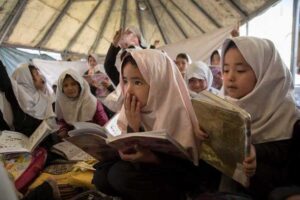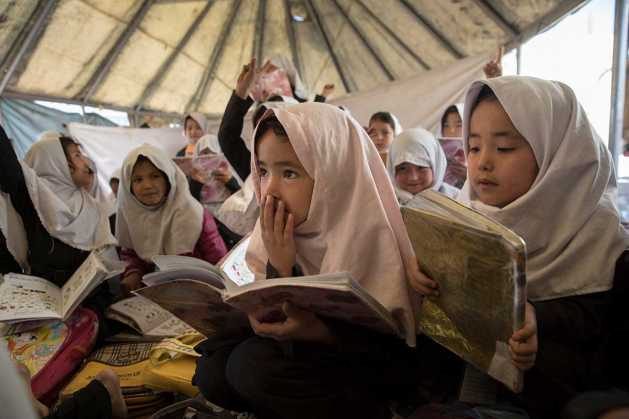
Asia-Pacific, Civil Society, Gender, Headlines, Human Rights, TerraViva United Nations
Heather Barr is associate women’s rights director at Human Rights Watch

Taliban violations of the rights of women and girls are uniquely extreme. No other country openly bars girls from studying on the basis of gender. Credit: 2017 Paula Bronstein for Human Rights Watch
– Secondary schools have reopened for boys but remain closed to the vast majority of girls. Women are banned from most employment; the Taliban government added insult to injury by saying women in their employ could keep their jobs only if they were in a role a man cannot fill—such as being an attendant in a women’s toilet. Women are mostly out of university, and due to new restrictions it is unclear when and how they can return. Many female teachers have been dismissed.
The policy of requiring a mahram, a male family member as chaperone, to accompany any woman leaving her home, is not in place according to a Kabul official but Taliban members on the street are still sometimes enforcing it, as well as harassing women about their clothing. The Taliban have systematically closed down shelters for women and girls fleeing domestic violence. Women’s sports have been banned.
The Taliban have appointed an all-male cabinet. They abolished the Ministry of Women’s Affairs, and handed over the women’s ministry building to the reinstated Ministry of Vice and Virtue, which was responsible for some of the worst abuses against women during the Taliban’s previous period in power from 1996 to 2001.
This was the situation two months after the Taliban had regained control of the Afghan capital, Kabul, as the US and its allies departed, wrapping up their 20-year engagement in Afghanistan’s 40-year war.
Afghan women are fighting for their rights. They tried to negotiate with the Taliban, and when that failed, they protested. The Taliban broke up their protests, beating protesters and the journalists covering the protests, and then banned unauthorized protest.
The US and the whole international community seem a bit stunned and unsure of what to do. It forms a sadly perfect bookend to the days after the 9/11 attacks, when the US and its allies grieved and raged and then emphasized Taliban abuses of women and girls to help them build support for their invasion of Afghanistan.
The US has long had an uneven—and self-serving—track record on defending women’s rights abroad. But the US is not alone being unsure of what to do to protect the rights of women and girls under Taliban rule.
Even governments priding themselves on their commitment to women’s rights have struggled to find solutions. They have also struggled to make the rights of Afghan women and girls a top priority at a moment when troop-contributing nations are licking their wounds, and concerns about Afghanistan again becoming a host to international terrorist operations could overshadow concerns about human rights.
Humanitarian crisis
Taliban attacks on rights are not the only problem women and girls are facing. Afghanistan’s economy is in free fall, set off by widespread lost income, cash shortages, rising food costs, being severed from global financial systems, and an abrupt halt to the development assistance that made up 75 percent of the previous government’s budget.
This crisis, like most humanitarian crises, will cause the most harm to women and girls. Officials with the UN and several foreign governments are warning of economic collapse and risks of worsening acute malnutrition and outright famine. Surveys by the World Food Program (WFP) reveal that over nine in ten Afghan families have insufficient food for daily consumption, with half saying that they ran out of food at least once in the previous two weeks. One in three Afghans is already acutely hungry.
In December 2020, the UN Children’s Fund, UNICEF, had already warned that an estimated 3.1 million children—half of Afghanistan’s children —were acutely malnourished. Other United Nations reports warn that over 1 million more children could face acute malnutrition in the coming year. By mid-2022, 97 percent of Afghans may be below the poverty line.
Healthcare workers and teachers, many of them women, have not been paid for months, and the healthcare system is collapsing. Where schools for girls are open, few students attend, out of fear that they cannot move to and from school safely, along with financial problems, and a sense of despair about their future. And unpaid teachers may or may not teach.
Weak international response
Even as it became increasingly clear over the course of years that cheerful US and NATO statements about their progress in defeating the Taliban were papering over huge and growing cracks, few could imagine a Taliban return as abrupt as the one that took place in August 2021. Few would have predicted this level of humanitarian crisis and collapse of essential services within weeks of the end of a 20-year military, political, and development engagement by at least 42 countries costing an estimated $2.3 trillion.
The early weeks of resumed Taliban rule seemed marked by indecision and slow response by the international community, in spite of a G7 pledge on August 24, following an emergency meeting, that “We will work together, and with our allies and regional countries, through the UN, G20 and more widely, to bring the international community together to address the critical questions facing Afghanistan.”
A special session of the UN Human Rights Council on August 24 produced no meaningful progress. The UN Security Council in September renewed the mandate of the UN mission in Afghanistan but did not take specific steps to strengthen the mission’s human rights work, which faced staffing gaps and problems after some staff left their posts or were evacuated.
A subsequent meeting of the Human Rights Council produced agreement to appoint a special rapporteur on human rights in Afghanistan, with a mandate including monitoring and advocating for the rights of women and girls. This is a less powerful mechanism than the fact-finding mission a broad coalition of human rights organizations had called for.
The resolution creating the role of special rapporteur provided the person with greater staffing resources than most special rapporteurs but did not accelerate the on-boarding process. Under the standard timeline, the rapporteur and their team won’t be in place until mid-2022.
An announcement by the International Criminal Court’s prosecutor called into question the role that body will play in protecting human rights in Afghanistan. The court’s Office of the Prosecutor had been considering action in Afghanistan since 2007 and opened an investigation in 2020.
Alleged war crimes and crimes against humanity within the court’s jurisdiction in Afghanistan include: attacks against civil servants including female officials; attacks on schools particularly girls’ schools; and rape and other sexual violence against women and girls. The investigation was suspended nearly as soon as it was opened, however, while the Office of the Prosecutor considered a request from the former Afghan government to defer to national proceedings.
The prosecutor on September 27, 2021, announced that he would seek authorization from the court to resume investigations in the absence of any prospect of genuine national proceedings, but would focus on crimes committed by the Taliban and Islamic State and “deprioritize” other aspects of the investigation.
This approach sends a message that some victims in Afghanistan are more entitled to justice than others, and risks undermining the legitimacy of the court’s investigation.
There is significant variety in the views of key countries about engaging with the new Taliban authorities in Afghanistan. Regional politics are fraught and complex. China and Russia may see themselves as benefitting from a shift in global power dynamics due to the US defeat in Afghanistan, and they and others including Pakistan and Qatar seem more ready than countries that contributed troops to engage with the Taliban. China, Russia and Pakistan were among only five countries that voted against the Human Rights Council resolution to establish a special rapporteur.
“Feminist foreign policy” and the Taliban
Women’s rights activists have made important progress around the world in the 20 years since the Taliban were previously in power, from 1996 to 2001. These advances make the Taliban’s violations of the rights of women and girls even more cruel and intolerable than they were in 2001 and should help spur action by countries that have made progress to right these wrongs.
In recent years, several countries—including Sweden, Canada, Mexico, and France—proclaimed that they have a “feminist foreign policy.” According to the Swedish government, a feminist foreign policy “means applying a systematic gender equality perspective throughout the whole foreign policy agenda.”
Feminist foreign policy is also a recognition that you cannot have human security when half the population is oppressed and living in fear. As Germany’s foreign minister wrote in 2020, “Numerous studies demonstrate that societies in which women and men are on equal footing are more secure, stable, peaceful, and prosperous.”
What Concerned Governments Should Do
How should a world increasingly embracing “feminist foreign policy” respond to Taliban violations of the rights of women and girls in 2021?
The first step is to muster political will. Lack of political may be a particular challenge in the wake of the withdrawal of foreign troops, but it is not a new problem. During the decades of international presence, troop-contributing nations paid lip service and contributed funding toward women’s rights, but rarely political capital, and over time the lip service and cash dwindled too.
In 2011, the Washington Post reported that efforts to support women’s rights were being stripped out of US programs, quoting an official who said, “All those pet rocks in our rucksack were taking us down.” In a disturbing indication of lack of focus on women’s rights, many government and aid organizations have in recent weeks sent all-male delegations to meet with the Taliban, undermining any efforts they are making to press for greater respect for women’s rights.
Then there is a need for the international community to reach as much consensus as possible about what the problems are and what should be done. There are signs that even countries that have been more open to engaging with the Taliban have been disappointed by their unwillingness to appoint an inclusive government and their violations of women’s and girls’ rights.
The Taliban government excludes not just women but also largely excludes religious minorities and most non-Pashtun ethnic groups. Even China, Russia, Pakistan and Iran have all called for the Taliban to form an “inclusive government.” Pakistan Prime Minister Imran Khan has said that banning girls from education in Afghanistan would be “un-Islamic.” Qatar’s foreign minister called the Taliban’s ban on girls’ education “very disappointing.”
The Taliban’s unbending stance on the rights of women and girls is so extreme that this, and its opposition to an inclusive government, may drive broad concern about their actions and help the international community build consensus about how to engage. The US may not be the most able leader for this process and may prefer not to lead.
Other countries and institutions, including countries that have pledged to have a feminist foreign policy, majority Muslim countries, and organizations like the EU, should consider taking on greater leadership than they have so far, in response to a weak response from the US.
Next comes the need for a plan. Whatever the plan is, it should avoid any actions that would worsen Afghanistan’s deepening humanitarian crisis and disproportionately affect women and girls. There are signs of emerging agreement for humanitarian assistance and essential services, with the United Nations Development Program having made arrangements to pay salaries of healthcare workers on a temporary basis.
But major issues remain unresolved, suffering from a lack consensus by the international community, including how to respond to Taliban efforts to exclude women from working for aid agencies . Women workers are essential to ensure that aid reaches women and women-headed households. so permitting women humanitarian workers to do their jobs is not setting a condition on humanitarian assistance so much as an operational necessity to be able to deliver that assistance.
The international community has struggled to identify what leverage they have that can be used to influence the Taliban. The situation has been complicated by opaqueness on the Taliban side. Governments and donors need to figure out what the Taliban want from the international community, how much and where the Taliban are willing to compromise to get what they want. And they need to identify what other pressures—including the demands of their own members and the risk of Taliban fighters defecting to the Islamic State—constrain the Taliban from compromise.
Equipped with this knowledge, the international community should recognize that almost every country on the planet—except six, conspicuously including the US, plus Iran, Palau, Somalia, Sudan, and Tonga—has ratified the Convention on the Elimination of All Forms of Discrimination against Women (CEDAW). Afghanistan ratified the convention in 2003. The convention requires countries to “pursue by all appropriate means and without delay a policy of eliminating discrimination against women.”
This promise has not been fulfilled in any country; no country has achieved full gender equality and disparities in access to education and employment, wage gaps, and failure to adequately respond to gender-based violence are common around the world. But even in that context, Taliban violations of the rights of women and girls are uniquely extreme.
No other country openly bars girls from studying on the basis of gender. It is shocking to see a country intentionally destroy its system for responding to gender-based violence and dismantle institutions such as the Ministry of Women’s Affairs that were designed to strengthen compliance with CEDAW.
The leverage the international community has to influence the Taliban needs to be deployed in defense of the rights of women and girls. Doing this will be a complex, difficult, and long-term task. But as
CEDAW members, and, in many cases, countries that used women’s rights to sell a war and spent 20 years promising eternal solidarity to Afghan women and girls, the international community owes them this effort.



